Critical Analysis of an Epidemiology Research Article: Report
VerifiedAdded on 2023/01/10
|11
|3009
|50
Report
AI Summary
This report presents a critical analysis of a research article by Byrne et al. (2007), which investigates the association between obstetric complications and the risk of schizophrenia. The analysis begins with an overview of the study, including its purpose, design, and key findings, such as the link between complications during pregnancy, birth, and the postpartum period, and the increased risk of schizophrenia. The report then appraises the internal validity of the study, discussing the clarity of results, potential biases, and confounding factors. The plausibility of a causal association between obstetric complications and schizophrenia is assessed, considering various factors like lack of antenatal visits and family history of psychiatric disorders. Finally, the external validity of the study is examined, considering the generalizability of the findings to different populations and the limitations of the study's conclusions. The report concludes by emphasizing the importance of the study's findings and acknowledging its limitations.
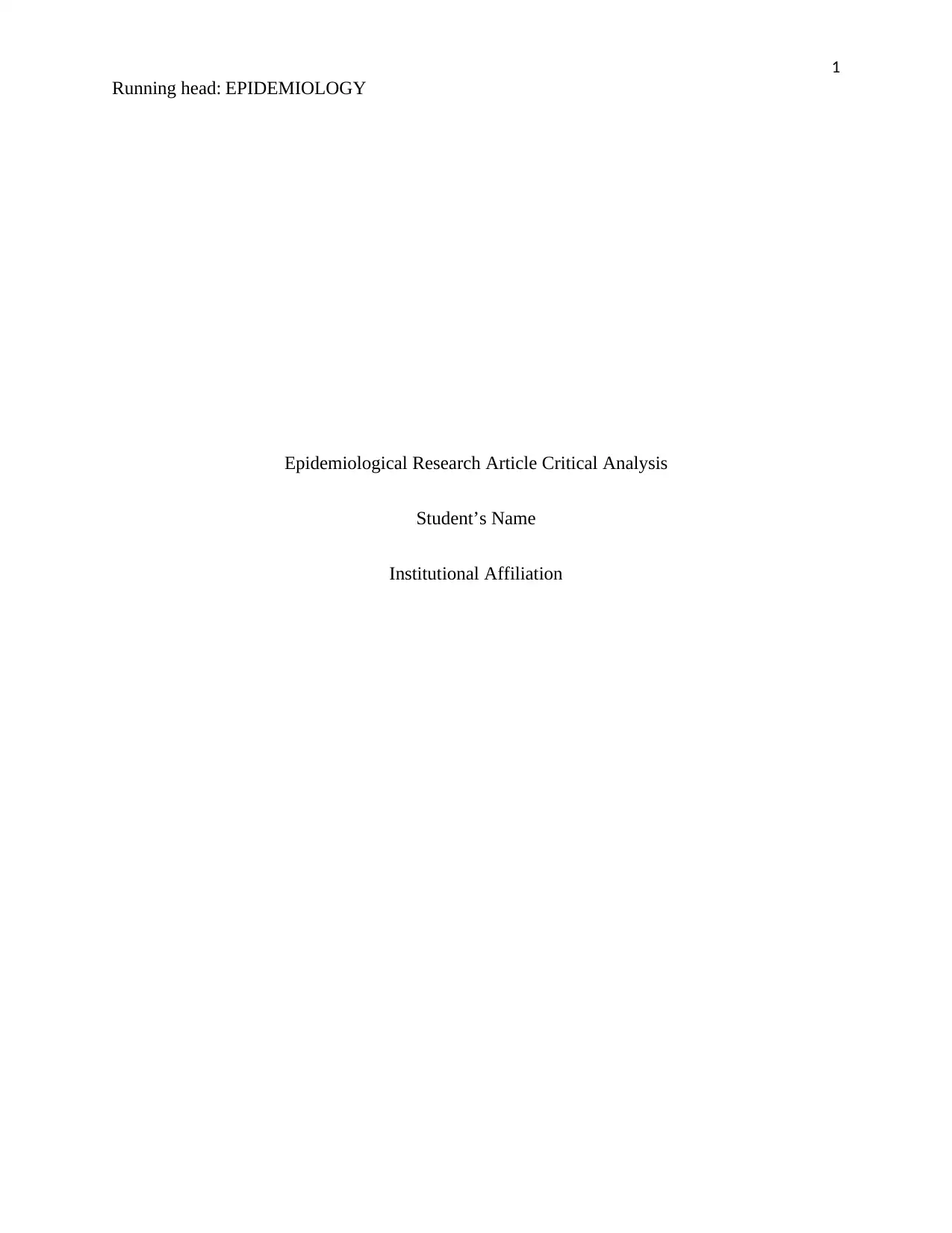
1
Running head: EPIDEMIOLOGY
Epidemiological Research Article Critical Analysis
Student’s Name
Institutional Affiliation
Running head: EPIDEMIOLOGY
Epidemiological Research Article Critical Analysis
Student’s Name
Institutional Affiliation
Paraphrase This Document
Need a fresh take? Get an instant paraphrase of this document with our AI Paraphraser
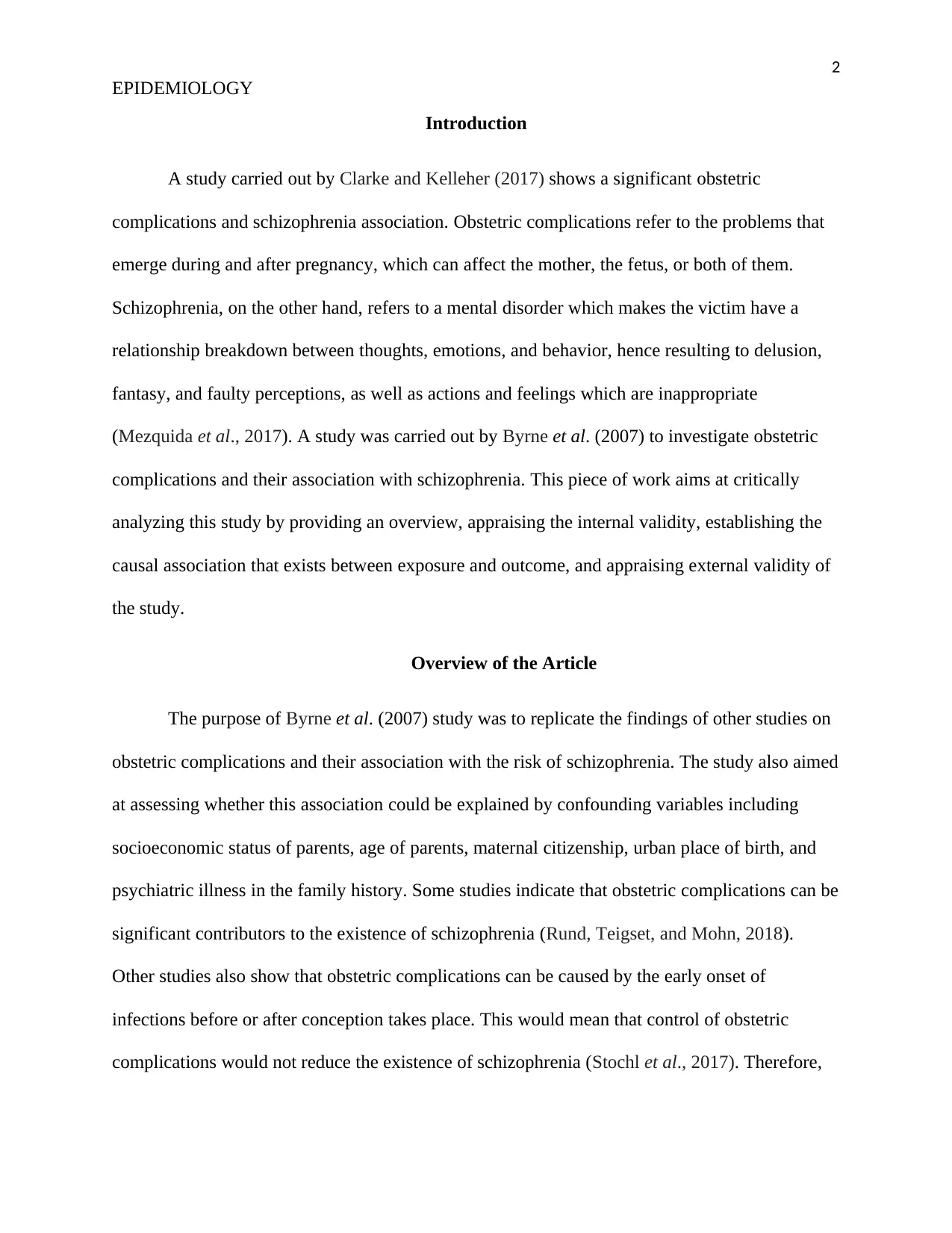
2
EPIDEMIOLOGY
Introduction
A study carried out by Clarke and Kelleher (2017) shows a significant obstetric
complications and schizophrenia association. Obstetric complications refer to the problems that
emerge during and after pregnancy, which can affect the mother, the fetus, or both of them.
Schizophrenia, on the other hand, refers to a mental disorder which makes the victim have a
relationship breakdown between thoughts, emotions, and behavior, hence resulting to delusion,
fantasy, and faulty perceptions, as well as actions and feelings which are inappropriate
(Mezquida et al., 2017). A study was carried out by Byrne et al. (2007) to investigate obstetric
complications and their association with schizophrenia. This piece of work aims at critically
analyzing this study by providing an overview, appraising the internal validity, establishing the
causal association that exists between exposure and outcome, and appraising external validity of
the study.
Overview of the Article
The purpose of Byrne et al. (2007) study was to replicate the findings of other studies on
obstetric complications and their association with the risk of schizophrenia. The study also aimed
at assessing whether this association could be explained by confounding variables including
socioeconomic status of parents, age of parents, maternal citizenship, urban place of birth, and
psychiatric illness in the family history. Some studies indicate that obstetric complications can be
significant contributors to the existence of schizophrenia (Rund, Teigset, and Mohn, 2018).
Other studies also show that obstetric complications can be caused by the early onset of
infections before or after conception takes place. This would mean that control of obstetric
complications would not reduce the existence of schizophrenia (Stochl et al., 2017). Therefore,
EPIDEMIOLOGY
Introduction
A study carried out by Clarke and Kelleher (2017) shows a significant obstetric
complications and schizophrenia association. Obstetric complications refer to the problems that
emerge during and after pregnancy, which can affect the mother, the fetus, or both of them.
Schizophrenia, on the other hand, refers to a mental disorder which makes the victim have a
relationship breakdown between thoughts, emotions, and behavior, hence resulting to delusion,
fantasy, and faulty perceptions, as well as actions and feelings which are inappropriate
(Mezquida et al., 2017). A study was carried out by Byrne et al. (2007) to investigate obstetric
complications and their association with schizophrenia. This piece of work aims at critically
analyzing this study by providing an overview, appraising the internal validity, establishing the
causal association that exists between exposure and outcome, and appraising external validity of
the study.
Overview of the Article
The purpose of Byrne et al. (2007) study was to replicate the findings of other studies on
obstetric complications and their association with the risk of schizophrenia. The study also aimed
at assessing whether this association could be explained by confounding variables including
socioeconomic status of parents, age of parents, maternal citizenship, urban place of birth, and
psychiatric illness in the family history. Some studies indicate that obstetric complications can be
significant contributors to the existence of schizophrenia (Rund, Teigset, and Mohn, 2018).
Other studies also show that obstetric complications can be caused by the early onset of
infections before or after conception takes place. This would mean that control of obstetric
complications would not reduce the existence of schizophrenia (Stochl et al., 2017). Therefore,
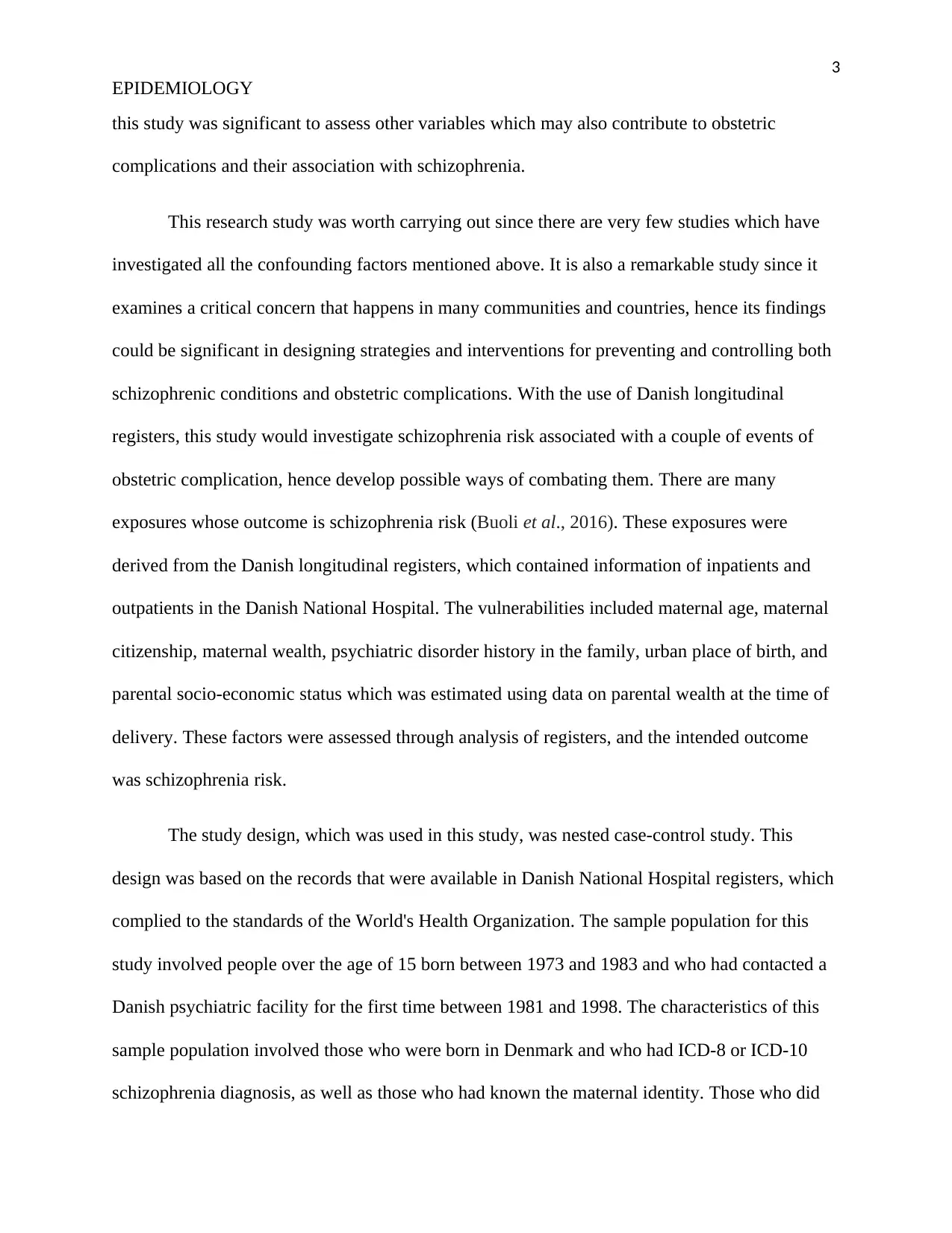
3
EPIDEMIOLOGY
this study was significant to assess other variables which may also contribute to obstetric
complications and their association with schizophrenia.
This research study was worth carrying out since there are very few studies which have
investigated all the confounding factors mentioned above. It is also a remarkable study since it
examines a critical concern that happens in many communities and countries, hence its findings
could be significant in designing strategies and interventions for preventing and controlling both
schizophrenic conditions and obstetric complications. With the use of Danish longitudinal
registers, this study would investigate schizophrenia risk associated with a couple of events of
obstetric complication, hence develop possible ways of combating them. There are many
exposures whose outcome is schizophrenia risk (Buoli et al., 2016). These exposures were
derived from the Danish longitudinal registers, which contained information of inpatients and
outpatients in the Danish National Hospital. The vulnerabilities included maternal age, maternal
citizenship, maternal wealth, psychiatric disorder history in the family, urban place of birth, and
parental socio-economic status which was estimated using data on parental wealth at the time of
delivery. These factors were assessed through analysis of registers, and the intended outcome
was schizophrenia risk.
The study design, which was used in this study, was nested case-control study. This
design was based on the records that were available in Danish National Hospital registers, which
complied to the standards of the World's Health Organization. The sample population for this
study involved people over the age of 15 born between 1973 and 1983 and who had contacted a
Danish psychiatric facility for the first time between 1981 and 1998. The characteristics of this
sample population involved those who were born in Denmark and who had ICD-8 or ICD-10
schizophrenia diagnosis, as well as those who had known the maternal identity. Those who did
EPIDEMIOLOGY
this study was significant to assess other variables which may also contribute to obstetric
complications and their association with schizophrenia.
This research study was worth carrying out since there are very few studies which have
investigated all the confounding factors mentioned above. It is also a remarkable study since it
examines a critical concern that happens in many communities and countries, hence its findings
could be significant in designing strategies and interventions for preventing and controlling both
schizophrenic conditions and obstetric complications. With the use of Danish longitudinal
registers, this study would investigate schizophrenia risk associated with a couple of events of
obstetric complication, hence develop possible ways of combating them. There are many
exposures whose outcome is schizophrenia risk (Buoli et al., 2016). These exposures were
derived from the Danish longitudinal registers, which contained information of inpatients and
outpatients in the Danish National Hospital. The vulnerabilities included maternal age, maternal
citizenship, maternal wealth, psychiatric disorder history in the family, urban place of birth, and
parental socio-economic status which was estimated using data on parental wealth at the time of
delivery. These factors were assessed through analysis of registers, and the intended outcome
was schizophrenia risk.
The study design, which was used in this study, was nested case-control study. This
design was based on the records that were available in Danish National Hospital registers, which
complied to the standards of the World's Health Organization. The sample population for this
study involved people over the age of 15 born between 1973 and 1983 and who had contacted a
Danish psychiatric facility for the first time between 1981 and 1998. The characteristics of this
sample population involved those who were born in Denmark and who had ICD-8 or ICD-10
schizophrenia diagnosis, as well as those who had known the maternal identity. Those who did
⊘ This is a preview!⊘
Do you want full access?
Subscribe today to unlock all pages.

Trusted by 1+ million students worldwide
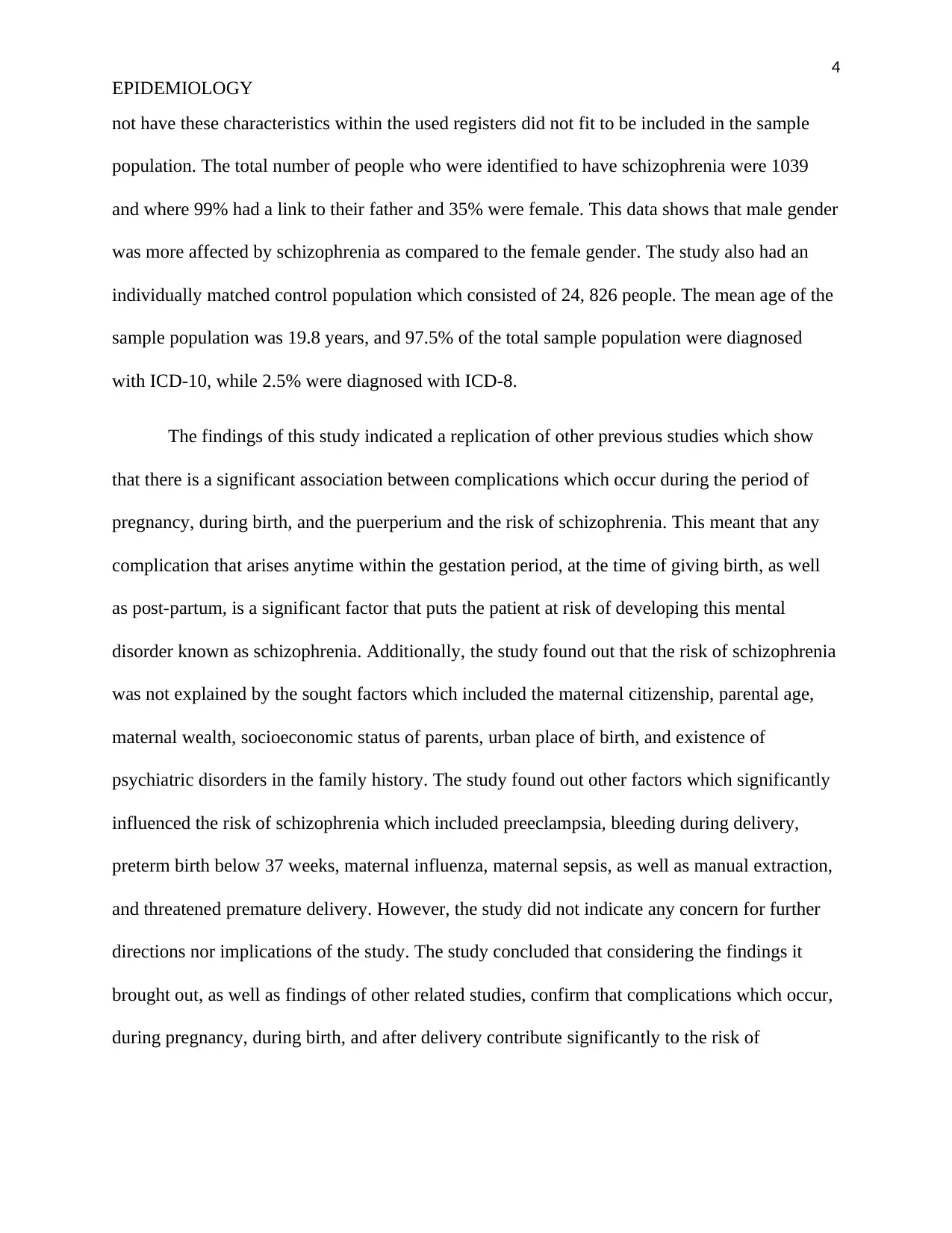
4
EPIDEMIOLOGY
not have these characteristics within the used registers did not fit to be included in the sample
population. The total number of people who were identified to have schizophrenia were 1039
and where 99% had a link to their father and 35% were female. This data shows that male gender
was more affected by schizophrenia as compared to the female gender. The study also had an
individually matched control population which consisted of 24, 826 people. The mean age of the
sample population was 19.8 years, and 97.5% of the total sample population were diagnosed
with ICD-10, while 2.5% were diagnosed with ICD-8.
The findings of this study indicated a replication of other previous studies which show
that there is a significant association between complications which occur during the period of
pregnancy, during birth, and the puerperium and the risk of schizophrenia. This meant that any
complication that arises anytime within the gestation period, at the time of giving birth, as well
as post-partum, is a significant factor that puts the patient at risk of developing this mental
disorder known as schizophrenia. Additionally, the study found out that the risk of schizophrenia
was not explained by the sought factors which included the maternal citizenship, parental age,
maternal wealth, socioeconomic status of parents, urban place of birth, and existence of
psychiatric disorders in the family history. The study found out other factors which significantly
influenced the risk of schizophrenia which included preeclampsia, bleeding during delivery,
preterm birth below 37 weeks, maternal influenza, maternal sepsis, as well as manual extraction,
and threatened premature delivery. However, the study did not indicate any concern for further
directions nor implications of the study. The study concluded that considering the findings it
brought out, as well as findings of other related studies, confirm that complications which occur,
during pregnancy, during birth, and after delivery contribute significantly to the risk of
EPIDEMIOLOGY
not have these characteristics within the used registers did not fit to be included in the sample
population. The total number of people who were identified to have schizophrenia were 1039
and where 99% had a link to their father and 35% were female. This data shows that male gender
was more affected by schizophrenia as compared to the female gender. The study also had an
individually matched control population which consisted of 24, 826 people. The mean age of the
sample population was 19.8 years, and 97.5% of the total sample population were diagnosed
with ICD-10, while 2.5% were diagnosed with ICD-8.
The findings of this study indicated a replication of other previous studies which show
that there is a significant association between complications which occur during the period of
pregnancy, during birth, and the puerperium and the risk of schizophrenia. This meant that any
complication that arises anytime within the gestation period, at the time of giving birth, as well
as post-partum, is a significant factor that puts the patient at risk of developing this mental
disorder known as schizophrenia. Additionally, the study found out that the risk of schizophrenia
was not explained by the sought factors which included the maternal citizenship, parental age,
maternal wealth, socioeconomic status of parents, urban place of birth, and existence of
psychiatric disorders in the family history. The study found out other factors which significantly
influenced the risk of schizophrenia which included preeclampsia, bleeding during delivery,
preterm birth below 37 weeks, maternal influenza, maternal sepsis, as well as manual extraction,
and threatened premature delivery. However, the study did not indicate any concern for further
directions nor implications of the study. The study concluded that considering the findings it
brought out, as well as findings of other related studies, confirm that complications which occur,
during pregnancy, during birth, and after delivery contribute significantly to the risk of
Paraphrase This Document
Need a fresh take? Get an instant paraphrase of this document with our AI Paraphraser

5
EPIDEMIOLOGY
schizophrenia. This is true following findings of a study carried out by Stochl et al. (2019) that
showed that obstetric complications have an association with schizophrenia.
Appraisal of the Internal Validity
The results of the study have been well analyzed and presented in a clear and
understandable way. However, analysis interpretation of the results required a person who is
knowledgeable in sophisticated statistical methods. Additionally, chance variance is likely to
affect the results because they only used information which was contained in the various
registers alone. This means that a study which is carried on the same topic with similar research
variables, some results would be found to be different. The results of the study showed that the
sought factors such as family history on psychiatric disorders, parental age, maternal citizenship,
maternal wealth, as well as the socio-economic status of parents did not have an impact on the
risk of schizophrenia. However, many studies indicate that these factors have an effect on the
occurrence of schizophrenia (Stochl et al., 2019). Therefore, other research studies which may
use data from other sources apart from hospital registers may show that the sought variables in
this study have an impact on schizophrenia risk.
Moreover, the study’s results are vulnerable to other biases. For example, the age of the
sample population was limited to an approximation of 19 years. Although this is the period in
which most people are at the risk of developing schizophrenia, other ages may also be at risk of
schizophrenia and, therefore, they could have been included in this study. Also, the family
history of psychiatric disorders was only assessed using the admitted cases, implying that the
study concentrated on severe cases of schizophrenia alone. The people who had schizophrenia
and did not get admitted to hospitals were not included in the study. These people would have an
impact on the results of this study if they were included in the study. The fact that hospital
EPIDEMIOLOGY
schizophrenia. This is true following findings of a study carried out by Stochl et al. (2019) that
showed that obstetric complications have an association with schizophrenia.
Appraisal of the Internal Validity
The results of the study have been well analyzed and presented in a clear and
understandable way. However, analysis interpretation of the results required a person who is
knowledgeable in sophisticated statistical methods. Additionally, chance variance is likely to
affect the results because they only used information which was contained in the various
registers alone. This means that a study which is carried on the same topic with similar research
variables, some results would be found to be different. The results of the study showed that the
sought factors such as family history on psychiatric disorders, parental age, maternal citizenship,
maternal wealth, as well as the socio-economic status of parents did not have an impact on the
risk of schizophrenia. However, many studies indicate that these factors have an effect on the
occurrence of schizophrenia (Stochl et al., 2019). Therefore, other research studies which may
use data from other sources apart from hospital registers may show that the sought variables in
this study have an impact on schizophrenia risk.
Moreover, the study’s results are vulnerable to other biases. For example, the age of the
sample population was limited to an approximation of 19 years. Although this is the period in
which most people are at the risk of developing schizophrenia, other ages may also be at risk of
schizophrenia and, therefore, they could have been included in this study. Also, the family
history of psychiatric disorders was only assessed using the admitted cases, implying that the
study concentrated on severe cases of schizophrenia alone. The people who had schizophrenia
and did not get admitted to hospitals were not included in the study. These people would have an
impact on the results of this study if they were included in the study. The fact that hospital

6
EPIDEMIOLOGY
registers were used in the study led to a total of 2.5% of those diagnosed with ICD-10. This
means that the removal of this 2.5% from the sample population would not have any significant
impact on the results. If the data of the sample population were obtained from real physical
people rather than using hospital registers would have a higher rate of people diagnosed with
ICD-10, hence impacting on the results of the study. A confounding factor that could have
affected the results of the study is the alteration of the information in the various registers. If
false information was recorded or if any intruder changed the information in the registers, the
results would be based on incorrect information, which would also result in invalid findings.
The strength of this study is that it had a sub-sample which showed more factors which
increase the risk of schizophrenia. These factors which were identified after the analysis of the
sub-sample included a history of provoked abortions, as well as lack of antenatal visits. This is a
support of the various obstetric complications which contribute to schizophrenia risks. A study
which has an additional sub-sample shows that its results are backed-up by more information,
hence adds to the validity of the results (Simoila et al., 2019). Also, the study assesses a broad
field which measures various factors from the time of conception to the birth of the child, hence
arriving at these findings is a hard task. This study is rated as one of the most extensive studies
which have been carried out, and yet most of its results are valid.
Plausibility of Causal Association between Exposure and Outcome
The association that has been brought out in this study between obstetric complications
and the risk of schizophrenia is plausible. This is because the various obstetric complications that
have been found assessed and analyzed thoroughly. For example, some other factors, such as
lack of antenatal visits, may pose a risk of schizophrenia. Failing to visit clinics during the
antenatal period means that any preventable or treatable risks are not dealt with, and hence may
EPIDEMIOLOGY
registers were used in the study led to a total of 2.5% of those diagnosed with ICD-10. This
means that the removal of this 2.5% from the sample population would not have any significant
impact on the results. If the data of the sample population were obtained from real physical
people rather than using hospital registers would have a higher rate of people diagnosed with
ICD-10, hence impacting on the results of the study. A confounding factor that could have
affected the results of the study is the alteration of the information in the various registers. If
false information was recorded or if any intruder changed the information in the registers, the
results would be based on incorrect information, which would also result in invalid findings.
The strength of this study is that it had a sub-sample which showed more factors which
increase the risk of schizophrenia. These factors which were identified after the analysis of the
sub-sample included a history of provoked abortions, as well as lack of antenatal visits. This is a
support of the various obstetric complications which contribute to schizophrenia risks. A study
which has an additional sub-sample shows that its results are backed-up by more information,
hence adds to the validity of the results (Simoila et al., 2019). Also, the study assesses a broad
field which measures various factors from the time of conception to the birth of the child, hence
arriving at these findings is a hard task. This study is rated as one of the most extensive studies
which have been carried out, and yet most of its results are valid.
Plausibility of Causal Association between Exposure and Outcome
The association that has been brought out in this study between obstetric complications
and the risk of schizophrenia is plausible. This is because the various obstetric complications that
have been found assessed and analyzed thoroughly. For example, some other factors, such as
lack of antenatal visits, may pose a risk of schizophrenia. Failing to visit clinics during the
antenatal period means that any preventable or treatable risks are not dealt with, and hence may
⊘ This is a preview!⊘
Do you want full access?
Subscribe today to unlock all pages.

Trusted by 1+ million students worldwide
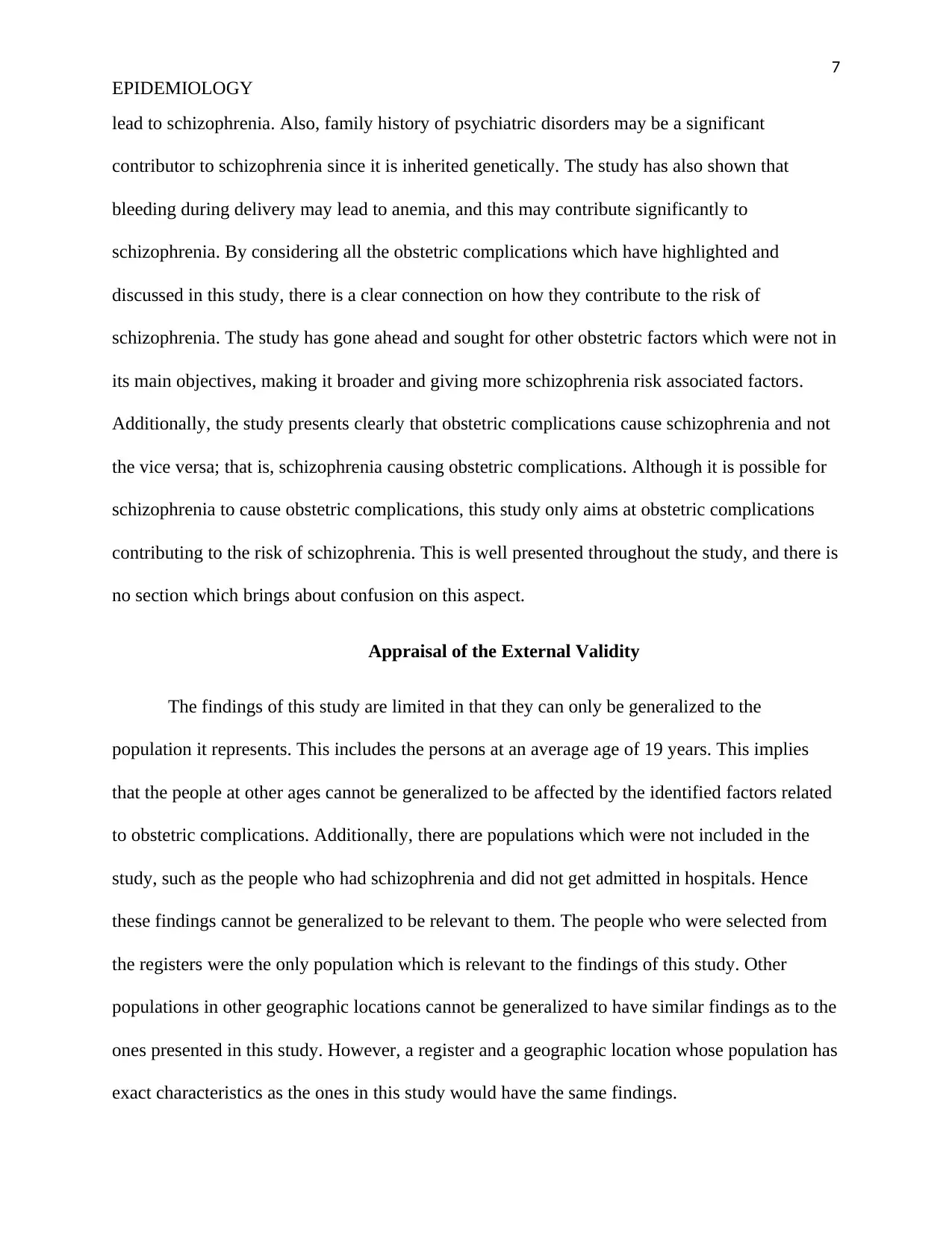
7
EPIDEMIOLOGY
lead to schizophrenia. Also, family history of psychiatric disorders may be a significant
contributor to schizophrenia since it is inherited genetically. The study has also shown that
bleeding during delivery may lead to anemia, and this may contribute significantly to
schizophrenia. By considering all the obstetric complications which have highlighted and
discussed in this study, there is a clear connection on how they contribute to the risk of
schizophrenia. The study has gone ahead and sought for other obstetric factors which were not in
its main objectives, making it broader and giving more schizophrenia risk associated factors.
Additionally, the study presents clearly that obstetric complications cause schizophrenia and not
the vice versa; that is, schizophrenia causing obstetric complications. Although it is possible for
schizophrenia to cause obstetric complications, this study only aims at obstetric complications
contributing to the risk of schizophrenia. This is well presented throughout the study, and there is
no section which brings about confusion on this aspect.
Appraisal of the External Validity
The findings of this study are limited in that they can only be generalized to the
population it represents. This includes the persons at an average age of 19 years. This implies
that the people at other ages cannot be generalized to be affected by the identified factors related
to obstetric complications. Additionally, there are populations which were not included in the
study, such as the people who had schizophrenia and did not get admitted in hospitals. Hence
these findings cannot be generalized to be relevant to them. The people who were selected from
the registers were the only population which is relevant to the findings of this study. Other
populations in other geographic locations cannot be generalized to have similar findings as to the
ones presented in this study. However, a register and a geographic location whose population has
exact characteristics as the ones in this study would have the same findings.
EPIDEMIOLOGY
lead to schizophrenia. Also, family history of psychiatric disorders may be a significant
contributor to schizophrenia since it is inherited genetically. The study has also shown that
bleeding during delivery may lead to anemia, and this may contribute significantly to
schizophrenia. By considering all the obstetric complications which have highlighted and
discussed in this study, there is a clear connection on how they contribute to the risk of
schizophrenia. The study has gone ahead and sought for other obstetric factors which were not in
its main objectives, making it broader and giving more schizophrenia risk associated factors.
Additionally, the study presents clearly that obstetric complications cause schizophrenia and not
the vice versa; that is, schizophrenia causing obstetric complications. Although it is possible for
schizophrenia to cause obstetric complications, this study only aims at obstetric complications
contributing to the risk of schizophrenia. This is well presented throughout the study, and there is
no section which brings about confusion on this aspect.
Appraisal of the External Validity
The findings of this study are limited in that they can only be generalized to the
population it represents. This includes the persons at an average age of 19 years. This implies
that the people at other ages cannot be generalized to be affected by the identified factors related
to obstetric complications. Additionally, there are populations which were not included in the
study, such as the people who had schizophrenia and did not get admitted in hospitals. Hence
these findings cannot be generalized to be relevant to them. The people who were selected from
the registers were the only population which is relevant to the findings of this study. Other
populations in other geographic locations cannot be generalized to have similar findings as to the
ones presented in this study. However, a register and a geographic location whose population has
exact characteristics as the ones in this study would have the same findings.
Paraphrase This Document
Need a fresh take? Get an instant paraphrase of this document with our AI Paraphraser

8
EPIDEMIOLOGY
The discussion section of this study has been presented in a clear way, which is easy to
understand. It presents the major findings of the study. Additionally, the discussion section
brings out the limitations of the study, an aspect which gives strength to the validity of the
findings of the study. This is because, a study which can identify its weaknesses means that it
was conducted well and its findings have been analyzed carefully with the acknowledgment of
the various limitations (Queiros, Faria and Almeida, 2017). Additionally, it incorporates research
from other sources to support its findings. This is used significantly to compare the findings of
this study to those of other related studies. Backing the findings with other literature means that
there are relevance and validity in the overall arguments made in the study.
Conclusion
This study aimed at replicating the obstetric complications and their association with the
risk of schizophrenia, as well as assessing this association with such factors as parental
socioeconomic status, maternal wealth, maternal citizenship, urban place of birth, age of parents,
and history of psychiatric disorders in the family. A nested case-control design was used in this
study. The sample population included 1039 people over the age of 15 years and who were born
in Denmark and had been diagnosed with ICD-8 or ICD-10 schizophrenia. The total sample
population consisted of 35% females and 97.5% of those who were diagnosed with ICD-10. The
findings of the study showed replication of findings of other studies, which indicated an
association between obstetric complications and schizophrenia. The findings further stated that
there is no explanation of the association between maternal citizenship, parental age, maternal
wealth, urban place of birth, and family history of psychiatric disorders and the risk of
schizophrenia. The factors which were found to have a substantial impact on the risk of
schizophrenia included bleeding during delivery, preterm birth, preeclampsia, maternal sepsis,
EPIDEMIOLOGY
The discussion section of this study has been presented in a clear way, which is easy to
understand. It presents the major findings of the study. Additionally, the discussion section
brings out the limitations of the study, an aspect which gives strength to the validity of the
findings of the study. This is because, a study which can identify its weaknesses means that it
was conducted well and its findings have been analyzed carefully with the acknowledgment of
the various limitations (Queiros, Faria and Almeida, 2017). Additionally, it incorporates research
from other sources to support its findings. This is used significantly to compare the findings of
this study to those of other related studies. Backing the findings with other literature means that
there are relevance and validity in the overall arguments made in the study.
Conclusion
This study aimed at replicating the obstetric complications and their association with the
risk of schizophrenia, as well as assessing this association with such factors as parental
socioeconomic status, maternal wealth, maternal citizenship, urban place of birth, age of parents,
and history of psychiatric disorders in the family. A nested case-control design was used in this
study. The sample population included 1039 people over the age of 15 years and who were born
in Denmark and had been diagnosed with ICD-8 or ICD-10 schizophrenia. The total sample
population consisted of 35% females and 97.5% of those who were diagnosed with ICD-10. The
findings of the study showed replication of findings of other studies, which indicated an
association between obstetric complications and schizophrenia. The findings further stated that
there is no explanation of the association between maternal citizenship, parental age, maternal
wealth, urban place of birth, and family history of psychiatric disorders and the risk of
schizophrenia. The factors which were found to have a substantial impact on the risk of
schizophrenia included bleeding during delivery, preterm birth, preeclampsia, maternal sepsis,
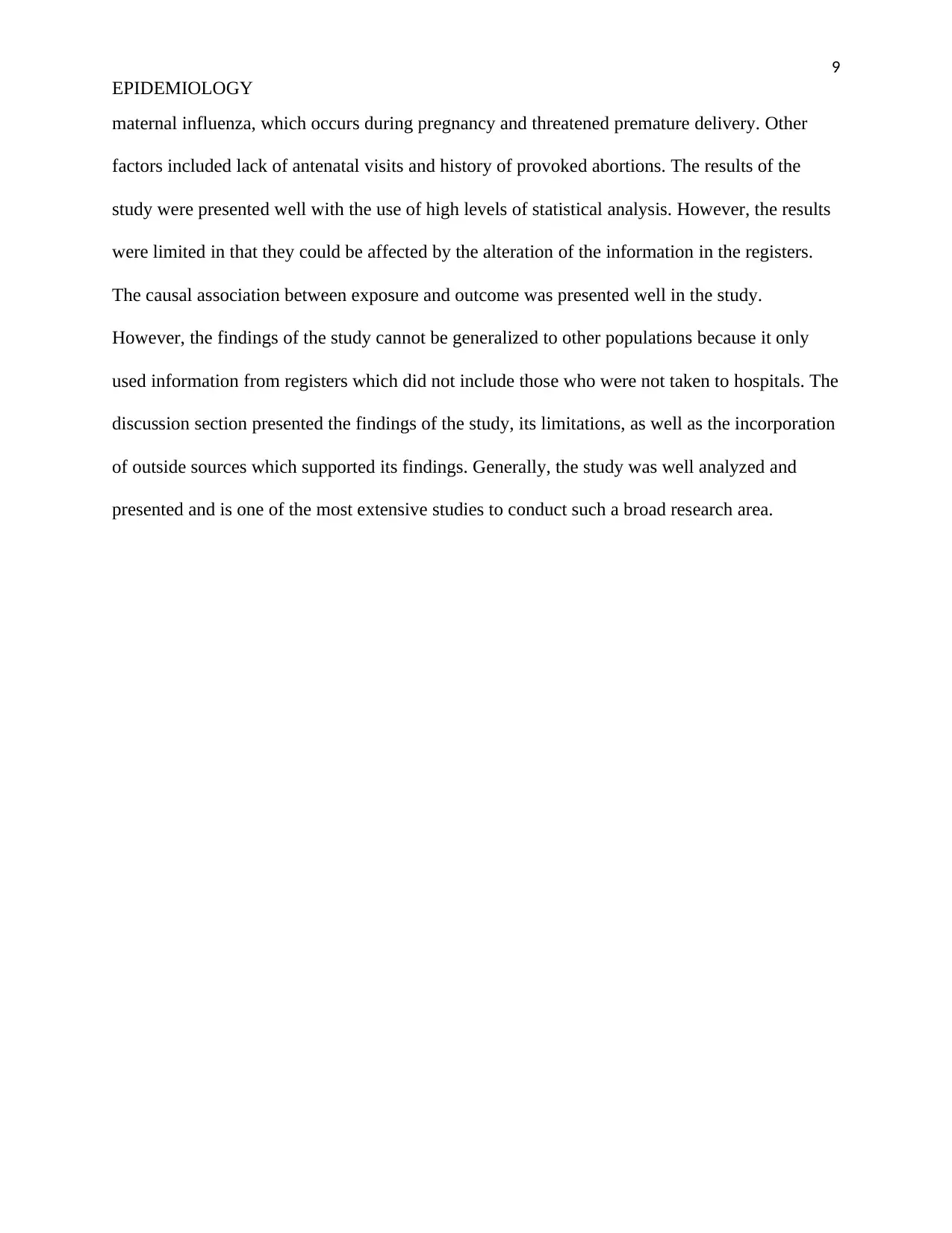
9
EPIDEMIOLOGY
maternal influenza, which occurs during pregnancy and threatened premature delivery. Other
factors included lack of antenatal visits and history of provoked abortions. The results of the
study were presented well with the use of high levels of statistical analysis. However, the results
were limited in that they could be affected by the alteration of the information in the registers.
The causal association between exposure and outcome was presented well in the study.
However, the findings of the study cannot be generalized to other populations because it only
used information from registers which did not include those who were not taken to hospitals. The
discussion section presented the findings of the study, its limitations, as well as the incorporation
of outside sources which supported its findings. Generally, the study was well analyzed and
presented and is one of the most extensive studies to conduct such a broad research area.
EPIDEMIOLOGY
maternal influenza, which occurs during pregnancy and threatened premature delivery. Other
factors included lack of antenatal visits and history of provoked abortions. The results of the
study were presented well with the use of high levels of statistical analysis. However, the results
were limited in that they could be affected by the alteration of the information in the registers.
The causal association between exposure and outcome was presented well in the study.
However, the findings of the study cannot be generalized to other populations because it only
used information from registers which did not include those who were not taken to hospitals. The
discussion section presented the findings of the study, its limitations, as well as the incorporation
of outside sources which supported its findings. Generally, the study was well analyzed and
presented and is one of the most extensive studies to conduct such a broad research area.
⊘ This is a preview!⊘
Do you want full access?
Subscribe today to unlock all pages.

Trusted by 1+ million students worldwide
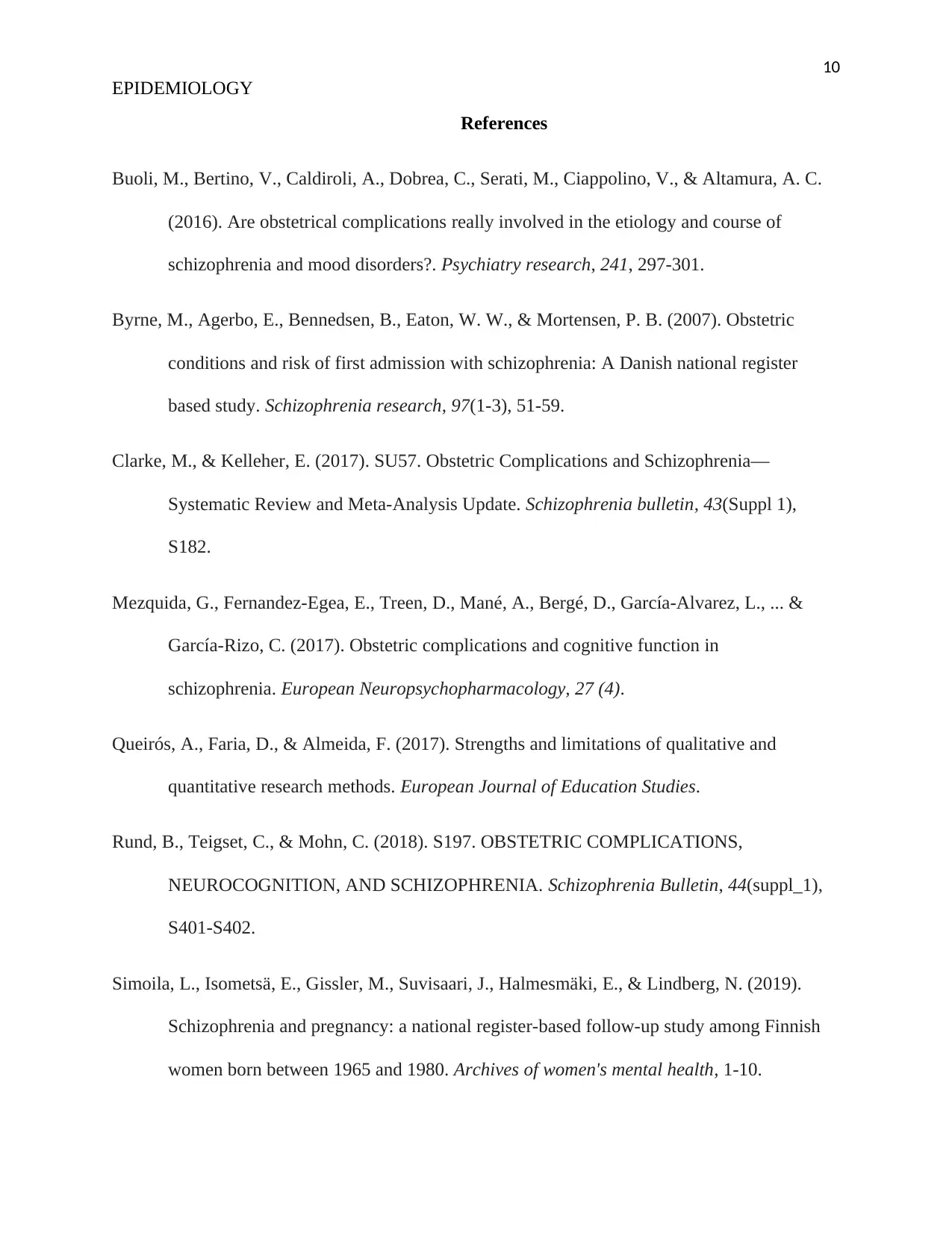
10
EPIDEMIOLOGY
References
Buoli, M., Bertino, V., Caldiroli, A., Dobrea, C., Serati, M., Ciappolino, V., & Altamura, A. C.
(2016). Are obstetrical complications really involved in the etiology and course of
schizophrenia and mood disorders?. Psychiatry research, 241, 297-301.
Byrne, M., Agerbo, E., Bennedsen, B., Eaton, W. W., & Mortensen, P. B. (2007). Obstetric
conditions and risk of first admission with schizophrenia: A Danish national register
based study. Schizophrenia research, 97(1-3), 51-59.
Clarke, M., & Kelleher, E. (2017). SU57. Obstetric Complications and Schizophrenia—
Systematic Review and Meta-Analysis Update. Schizophrenia bulletin, 43(Suppl 1),
S182.
Mezquida, G., Fernandez-Egea, E., Treen, D., Mané, A., Bergé, D., García-Alvarez, L., ... &
García-Rizo, C. (2017). Obstetric complications and cognitive function in
schizophrenia. European Neuropsychopharmacology, 27 (4).
Queirós, A., Faria, D., & Almeida, F. (2017). Strengths and limitations of qualitative and
quantitative research methods. European Journal of Education Studies.
Rund, B., Teigset, C., & Mohn, C. (2018). S197. OBSTETRIC COMPLICATIONS,
NEUROCOGNITION, AND SCHIZOPHRENIA. Schizophrenia Bulletin, 44(suppl_1),
S401-S402.
Simoila, L., Isometsä, E., Gissler, M., Suvisaari, J., Halmesmäki, E., & Lindberg, N. (2019).
Schizophrenia and pregnancy: a national register-based follow-up study among Finnish
women born between 1965 and 1980. Archives of women's mental health, 1-10.
EPIDEMIOLOGY
References
Buoli, M., Bertino, V., Caldiroli, A., Dobrea, C., Serati, M., Ciappolino, V., & Altamura, A. C.
(2016). Are obstetrical complications really involved in the etiology and course of
schizophrenia and mood disorders?. Psychiatry research, 241, 297-301.
Byrne, M., Agerbo, E., Bennedsen, B., Eaton, W. W., & Mortensen, P. B. (2007). Obstetric
conditions and risk of first admission with schizophrenia: A Danish national register
based study. Schizophrenia research, 97(1-3), 51-59.
Clarke, M., & Kelleher, E. (2017). SU57. Obstetric Complications and Schizophrenia—
Systematic Review and Meta-Analysis Update. Schizophrenia bulletin, 43(Suppl 1),
S182.
Mezquida, G., Fernandez-Egea, E., Treen, D., Mané, A., Bergé, D., García-Alvarez, L., ... &
García-Rizo, C. (2017). Obstetric complications and cognitive function in
schizophrenia. European Neuropsychopharmacology, 27 (4).
Queirós, A., Faria, D., & Almeida, F. (2017). Strengths and limitations of qualitative and
quantitative research methods. European Journal of Education Studies.
Rund, B., Teigset, C., & Mohn, C. (2018). S197. OBSTETRIC COMPLICATIONS,
NEUROCOGNITION, AND SCHIZOPHRENIA. Schizophrenia Bulletin, 44(suppl_1),
S401-S402.
Simoila, L., Isometsä, E., Gissler, M., Suvisaari, J., Halmesmäki, E., & Lindberg, N. (2019).
Schizophrenia and pregnancy: a national register-based follow-up study among Finnish
women born between 1965 and 1980. Archives of women's mental health, 1-10.
Paraphrase This Document
Need a fresh take? Get an instant paraphrase of this document with our AI Paraphraser

11
EPIDEMIOLOGY
Stochl, J., Whittier, A., Wagner, A. P., Veijola, J., Jääskeläinen, E., Miettunen, J., ... & Jones, P.
B. (2019). Association between developmental milestones and age of schizophrenia
onset: results from the Northern Finland birth cohort 1966. Schizophrenia research.
EPIDEMIOLOGY
Stochl, J., Whittier, A., Wagner, A. P., Veijola, J., Jääskeläinen, E., Miettunen, J., ... & Jones, P.
B. (2019). Association between developmental milestones and age of schizophrenia
onset: results from the Northern Finland birth cohort 1966. Schizophrenia research.
1 out of 11
Your All-in-One AI-Powered Toolkit for Academic Success.
+13062052269
info@desklib.com
Available 24*7 on WhatsApp / Email
![[object Object]](/_next/static/media/star-bottom.7253800d.svg)
Unlock your academic potential
Copyright © 2020–2025 A2Z Services. All Rights Reserved. Developed and managed by ZUCOL.


